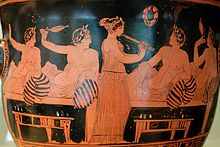 |
| Photo Marie-Lan Nguyen Source Wikipedia |
Before I left for Birmingham I listened to a panel discussion advertised as a State of the Art Panel Discussion: Narrative Dance in Ballet. It took place in the Stanley and Audrey Burton Theatre between 13:15 and 15:00 on 20 June. The panel was chaired by Mike Dixon and consisted of the critics Mary Brennan, Louise Levene and Graham Watts, Christopher Hampson, the artistic director of Scottish Ballet and dancers Tobias Batley and Dreda Blow.
Northern Ballet's artistic director, David Nixon, introduced the session by explaining that this discussion was part of the Tell Tale Steps programme the purpose of which was research. He described the work that had been carried out by Kenneth Tindall, Ludovic Ondiviela, Constant Vigier and Andrew McNicol as a "laboratory" and not a workshop. The crucial difference, he explained, is that a workshop is for creating things whereas a laboratory is where experiments take place.
It all sounded very exciting and I awaited inspiration and erudition with bated breath. Although it was a very interesting discussion that did not exactly happen. I certainly didn't learn anything I did not already know or could not easily have looked up on Google. If that was the case for me it must have been even more true for Nixon and the other dance makers and dance artists who attended.
The problem was that the panel was too large and their experience was too diverse. Each of the speakers spoke about his or her personal experience. The critics spoke about the criteria for judging a ballet. Hampson spoke about how he creates a ballet which is very personal. Batley spoke about his reading before works starts on a new ballet and produced his copy of The Great Gatsby bristling with post it notes. He gave an example of how he considered a sentence in the novel about his character's smile and tried to incorporate it into his performance. Blow spoke about the ballet that she had created for children.
To me the discussion was unfocussed. Maybe because I am a lawyer I would have appreciated some definitions. The title of the discussion was "Narrative Dance in Ballet" but what exactly did the panellists mean by "narrative dance"? Something with a plot like Sleeping Beauty? But that would exclude an awful lot of ballets like Les Sylphides which has characters like sylphs and a poet and indeed tells a story but does not have a plot as such. On the other there are some ballets like Giselle where the plot is best forgotten. Others like The Nutcracker where the plot is tenuous at best. I was bursting to ask that question from very early in the discussion but I did not get my opportunity until the very end. In fact, only Gita and I managed to get a word in edgeways.
There were topics that I really wish the panel could have developed. Brennan mentioned the work of Peter Darrell who was artistic director of Western Theatre Ballet when it moved to Glasgow. Another panellist mentioned all the versions of Cinderella that had been produced lately including Hampson's and wondered whether there was a trend. Yet another discussed how technology enabled dance makers to explore topics that could not have been addressed before. Anther opined that it was impossible to choreograph ballets to Beethoven. I could have contributed to all those discussions.
The topic I most wanted to discuss was Darrell. I was at St Andrews when Western Theatre Ballet moved to Glasgow and one of our professors was John Steer who later chaired the company. Scottish Theatre Ballet (as the company called itself after the move) was the first company that I got to know and love. That was because Darrell had ignited my love of ballet. I met him once and got to know some of his dancers better. I am still a Friend of Scottish Ballet and I greatly admire the work of Hampson, his successor. Some of the things that were said about Darrell, his work and legacy did not sound quite right,
Although the panel discussed Cinderella, nobody mentioned Darius James's version for Ballet Cymru which I saw last week and is the very best version of the story I have seen to date (see Ballet Cymru's Cinderella 15 June 2015). They spoke about Ashton's, Ratmansly's, "Christopher's" (I am not sure whether they were referring to Wheeldon or Hampson) but not the gem that has recently been touring the nation.
On the use of technology and whether it increases the dance maker's range I wanted to sound a note of caution. The use of film to represent flashbacks was not new. I had seen MacMillan's Anastasia and modern choreographers should treat such technologies with circumspection.
As to whether Beethoven can be choreographed, nobody mentioned Ashton's magnificent Creatures of Prometheus to the Eroica symphony which marked the bicentenary of the composer's birth.
I had hoped to introduce myself to Hampson and Watts but the panellists were whisked away to the boardroom after the discussion. Gita buttonholed Brennan for a while and she seemed to want to talk but even Brennan was eventually RKO'd from the profanum vulgus by a minder. I think that was a big mistake (huge) on the part of the organizers. The folk who gave up their Saturday afternoons to attend the seminars are the ones who keep the ballerinas in pointe shoes, whether as theatre goers, taxpayers, Friends of the company or in many cases all three and we have ideas, views and experiences to contribute that could be useful.

No comments:
Post a Comment